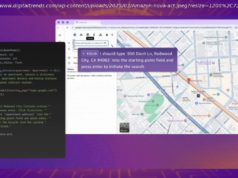Dual-4K meets mini-LED all over again
There is no single display technology that does everything well. That’s an objective fact and something the stupendous, incredible and delightful new Acer Predator Z57 does absolutely nothing to change. Along with the closely related Samsung Odyssey Neo G9 G95NC, this is one of if not the most spectacular gaming monitors available today. And yet it’s also pretty clearly flawed.
Hold that thought while we cover off the basics. What you’re looking at here is a monstrous 57-inch dual-4K monitor. The resolution clocks in at 7,680 by 2,160 pixels, so it’s literally two 4K pixel grids fused together.
Where a 4K monitor as as 16:9 aspect ratio, this thing is twice as wide at 32:9. The pixel density on the 57-inch panel works out at 140 DPI. That means this display is exactly equivalent to a pair of 32-inch 4K monitors, side-by-side. It is, in a word, bananas.
In that regard, it’s similar to the various 49-inch ultra-wide monitors that have been available for some time, such as the Samsung Odyssey OLED G9, just taken to a whole new level. Those monitors offer 5,120 by 1,440 pixels and are essentially two 27-inch 1440p panels in one.
Anyway, the appeal here is the pixel density of a 32-inch 4K monitor but on a much, much grander scale. Of course, with that epic pixel count comes equally outlandish GPU load. If 4K doesn’t already beat GPUs into submission, how about two times 4K? Better get that DLSS and triple-pumped frame gen spooled up, eh?
It’s a lot for any graphics card to deal with when it comes to achieving playable frame rates in modern games. Which is why we can probably forgive the relatively modest 120 Hz refresh rate. You’re not exactly going to be playing Half-Life 2 RTX at 300 fps, even with upscaling and frame gen, on this thing.
That said, the 120 Hz is the first obvious divergence between this Acer and the aforementioned Samsung Odyssey Neo G9 G95NC. To the best of our knowledge, this Acer uses the same Samsung-supplied VA panel. But the G95NC rocks a 240 Hz refresh courtesy of being one of the first displays to offer DisplayPort 2.1.
The Predator Z57 only has DisplayPort 1.4 and HDMI 2.1, neither of which are good for 240 Hz at this resolution. To put it into context, running this monitor at 240 Hz is equivalent in bandwidth terms to eight 4K monitors at 60 Hz. Ouch.
One other area of differentiation involves the mini-LED technology that powers both displays and that is also the source of their most obvious issues. The Samsung G9 has 2,392 zones while this Acer sports 2,304 zones. It seems unlikely that they actually have different mini-LED backlights, so the slight zone count difference may be down to how the individual mini-LED lights are addressed and controlled.
Either way, this monitor offers the same 1,000 nit peak HDR brightness and VESA DisplayHDR 1000 certification, though Acer claims a superior 98% coverage of DCI-P3 to the Samsung’s 95%. In practice, these are very similar displays, only the Samsung’s 240 Hz support is really material.
Another element that’s shared across both monitors is very challenging ergonomics. This is a huge monitor that demands copious desk space. Just getting it out of the box is quite the ordeal. I’d rather not go into the sordid details, but let’s just say I learned the hard way how not to do it with the similarly proportioned Samsung. Whoops.
Still, you do get decent connectivity. Along with the DisplayPort and HDMI inputs, there’s USB-C with 90 W of power delivery, plus a KVM switch and picture-in-picture and picture-by-picture support.






